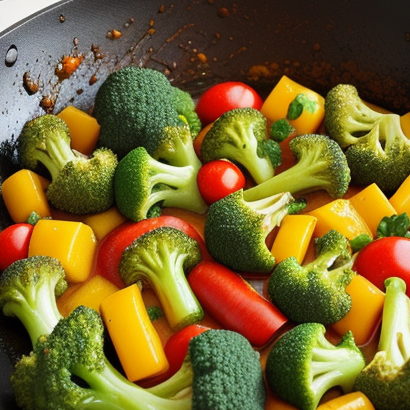
Variety is the spice of life, and when it comes to stir-frying, a medley of colorful vegetables is what you’re after. Each hue not only brightens up your plate but also packs in unique nutritional benefits. Reds like bell peppers and tomatoes are loaded with vitamin C and antioxidants. Greens such as broccoli and spinach? They’re your go-to for fiber and folate. Adding yellows and oranges like carrots or squash gives you a shot of vitamin A and potassium, while purples like eggplant or cabbage offer up anthocyanins, the same heart-healthy compounds found in blueberries.
The trick to a visually stunning and nutrient-dense stir-fry is selecting a variety that covers the full spectrum of colors. Next time you’re at the grocery store or farmers’ market, imagine you’re creating a rainbow on your plate. Aim for at least four different colors, and you’ll not only improve the nutrition but also the taste and texture of your dish.
A mix of colors introduces different flavors and levels of sweetness and bitterness, making your stir-fry more complex and interesting. Plus, those pops of colors mean your dish looks as good as it tastes, which matters because we all eat with our eyes first.
Beyond just picking random colors of vegetables, think about how each one contributes to the overall dish. Some vegetables have a high water content and will steam, while others might caramelize and add depth with a bit of charring. Balancing these elements ensures each bite is uniquely satisfying and delicious.
Enhancing Flavor & Texture: Mastering the Art of Stir-Frying

Ready to take your stir-fry game to the next level? The secret lies in the art of balancing flavor and texture. Start with fresh, high-quality ingredients. They’ll make a world of difference in the final dish. Don’t just grab what’s on sale; pick vegetables with firm skin and vibrant colors that speak of their freshness.
For that perfect stir-fry, a key move is prepping all your ingredients before you even heat up the pan. Cut your vegetables into uniform sizes to ensure even cooking. This not only saves you from a chaotic kitchen rush but guarantees consistently cooked veggies.
The foundation of any great stir-fry is high heat. A hot wok or pan is crucial. It creates that seared, smoky flavor known as wok hei in Cantonese cuisine. Flash cook your vegetables to keep them crisp and bright, not soggy and dull. Keep the veggies moving—this is the dance of a good stir-fry. It ensures they don’t burn and allows every side to cook evenly.
Let’s talk gear. While a seasoned wok is ideal, a sturdy sauté pan can do the trick if you’re just starting out. The key is to preheat it until it shimmers a bit. Then, use oils with a high smoke point like peanut or canola oil. Skip the olive oil—it burns too easily at high temps.
Finally, let’s spice things up. Garlic, ginger, and scallions are your flavor powerhouses. Start with these aromatics to infuse their essence into the oil, laying down a fragrant foundation for your veg. Add soy sauce, sesame oil, and maybe a dash of rice vinegar or hoisin sauce toward the end to tie all the flavors together. This step ensures a rich, layered taste—not just sweet or salty, but a blend that keeps every bite interesting.
Sauteed to Perfection: Creating Layers of Taste

Creating a flavor-packed sauteed vegetable dish is both an art and a science. Start by selecting the freshest vegetables you can find, just like in your stir-fry. But here, the goal is to slowly coax out their natural sweetness and complexity over medium heat; patience is key.
Timing is everything. Start with the vegetables that take the longest to cook. Root vegetables, for example, will need a bit more time to soften and develop a golden crust. As they cook, sprinkle a pinch of salt to help release their natural juices, making them more flavorful.
Aromatics like garlic, shallots, or ginger should be your next layer. These elements are minor in quantity but mighty in flavor, elevating the taste profile as they become translucent and release their aroma throughout the veggies. Add them towards the middle of the cooking process to prevent them from burning.
For additional complexity, consider incorporating a balancing act of acidity and sweetness. A splash of lemon juice or a spoonful of balsamic vinegar can brighten and enhance flavors, cutting through any richness while a drizzle of honey or maple syrup can add a subtle sweetness, harmonizing the entire dish.
Finish strong with fresh herbs like basil, cilantro, or parsley. Toss them in just before serving to preserve their brightness and let their aromatic flavors pop. They’re like the fireworks that cap off a perfect meal, offering that little zing that can make your dish truly special.




This post does a fantastic job of highlighting both the nutritional and aesthetic appeal of using a variety of colorful vegetables in stir-fry dishes. The detailed tips for enhancing flavor and texture, like using aromatics and balancing cooking times, make it a great resource for home cooks aiming to up their stir-fry game.
What are some plant-based protein options that pair well with a colorful vegetable stir-fry to create a complete, satisfying meal?